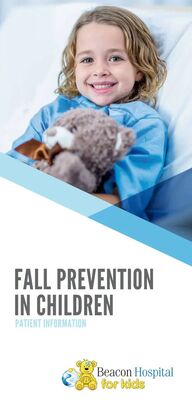
Return to flip book view
Be aware of floor hazards or obstacles such as pets small objects or uneven surfaces Do not allow children to climb on furniture Use non slip adhesive or rubber mats in the bath Ensure the child s shoes are correctly fitted and straps laces are correctly fastened Rubber soles are preferably Make sure all assistive walking equipment is in good working condition Is Your Child a Falls Risk Is the child light headed dizzy upon standing up A drop in blood pressure as they stand can cause this Is the child on multiple medications Some medications increase the falls risk Be aware of advice given on medications Unsteady when walking Gentle exercise can help to improve your child s balance strengthen their muscles and decrease falls Toilet Ask the child to go to the toilet when they need to go rather than waiting and needing to rush at the last second FALL PREVENTION IN CHILDREN Hearing Eyesight Problems Ensure clear pathways are available for the child Problems with the child s feet Foot problems can affect how your child walks and their balance Ensure shoes are well fitting and securely fastened If the child suffers any change to leg or foot sensation or power discuss this with your doctor or nurse PATIENT INFORMATION Beacon Hospital Sandyford Dublin 18 D18 AK68 Tel 01 293 6600 www beaconhospital ie Version 2 10 2022
FALL PREVENTION IN CHILDREN PATIENT INFORMATION Paediatric Falls Information How to Help Us Help You When a child has surgery he she may be even more prone to falls Ensure your child wears runners or slippers with non skid soles at all times There are a few reasons that your child may be more likely to fall or have an accident Notify the staff if there is a spill or other hazard on the floor The medication used can make them sleepy A parent guardian must stay with their child at all times If a parent guardian is leaving for any reason they must inform the nurse of this Your child may experience a decreased sensation in an area and have lost the ability to move parts of their body Your child may be weak or have unsteady balance and coordination The hospital is an unfamiliar environment for your child Beacon Hospital has developed a programme designed to enhance your child s care while you are with us Our efforts only be successful with your help Keep the area on both sides of the cot or bed clear Hospital beds are taller than your child s bed at home Keep the bed in the lowest position with wheels locked Keep cot sides up and latched whenever your child is in the crib bed unless you are providing care Go with your child to the bathroom when they have medical equipment attached Go with your child to the bathroom when they get up for the first time after surgery Please ask us for help if you are unsure Do not share a bed with your child Home Safety Tips Considerations Some simple measures in your home will help you develop good safety habits and prevent accidental falls Rearrange furniture to make it easy to get around Cover slippery surfaces with carpets that are firmly anchored to the floor with no edges to trip over Your nurse will be happy to answer any questions you may have after you read this leaflet All children who fall asleep outside of their crib bed should be returned to their crib bed Please do this before you get tired and are ready for sleep Special Measures Keep the nurse s call button within reach Remove all throw rugs All children are deemed at risk of having a fall For this reason at registration a purple band will be applied to your child s wrist If your child s movement is restricted be sure he she is helped when standing up by you or hospital staff Clean up spills immediately Do not allow running or climbing on furniture or in the hospital Use the safety straps of an infant seat stroller highchair etc Area carpets should be fastened to the floor with double faced tape to prevent carpets from slipping and edges from curling up Provide good lighting throughout the house leave a light on at night to show the way to the bathroom or use a bedside commode Where appropriate place bedside commode up against the wall